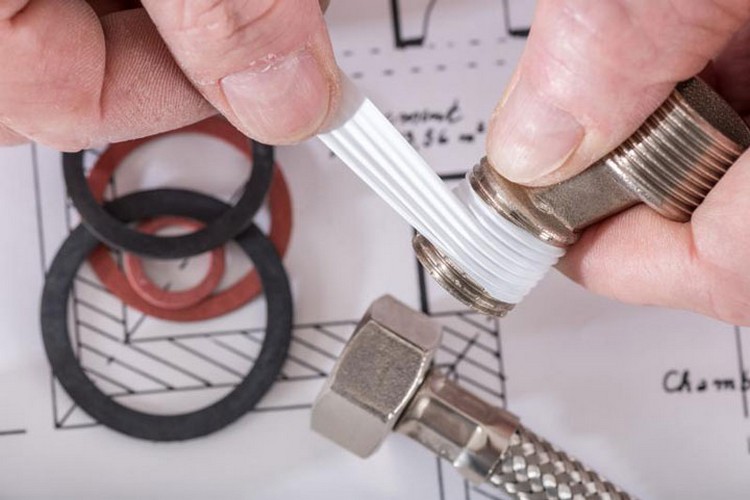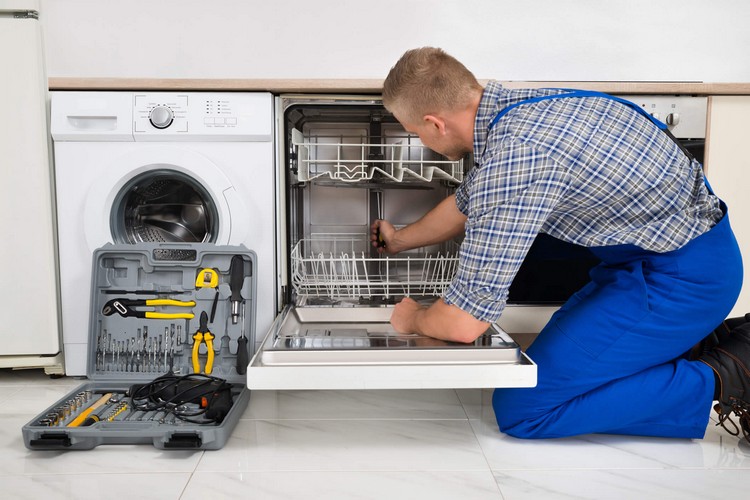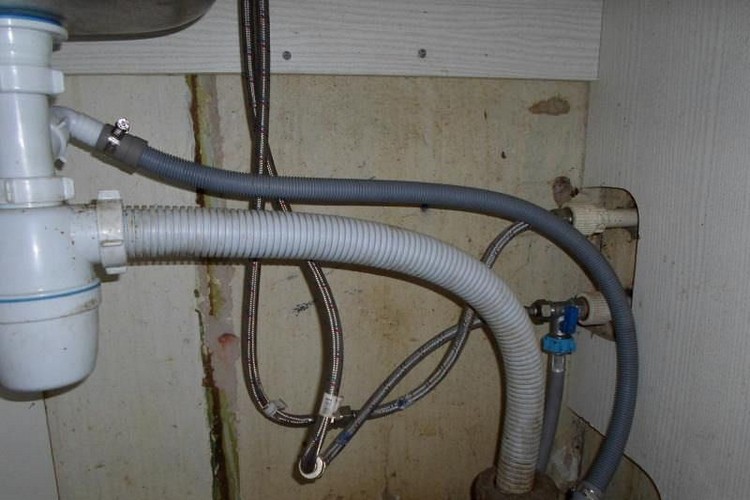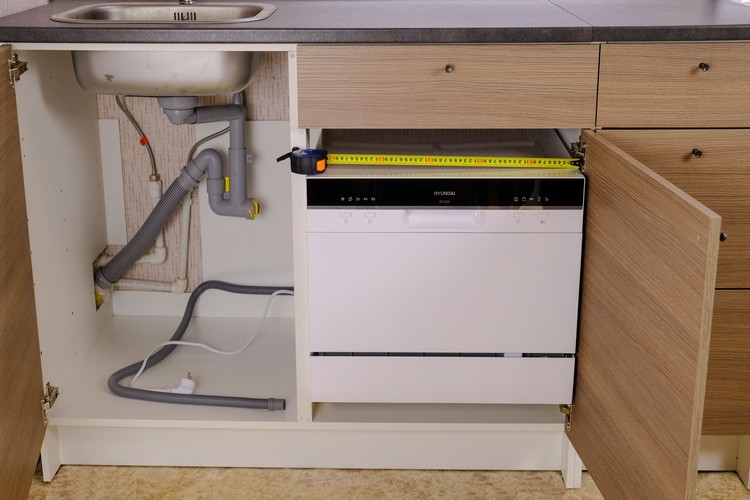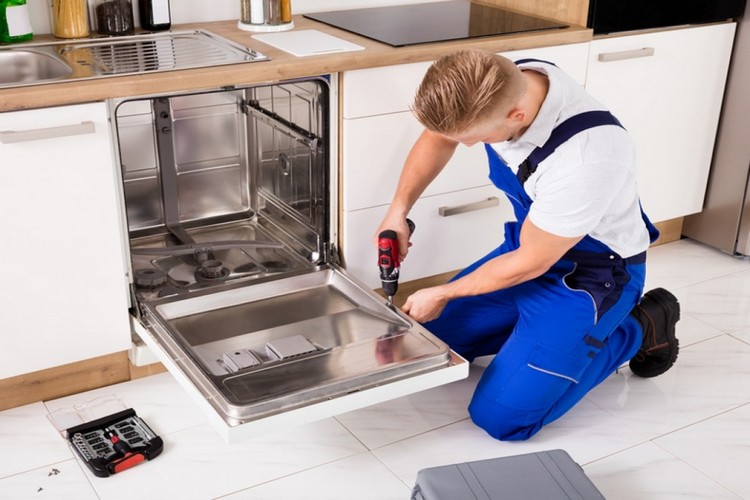Detailed guide: Installing and connecting the dishwasher to the water, sewer and power grid
 Installing a dishwasher is not a complicated matter.
Installing a dishwasher is not a complicated matter.
But even in this simple algorithm there are a lot of nuances that need to be taken into account.
Where it is better to put the dishwasher, how to calculate the distance, what tools are needed and how to do it?
How to install, connect and configure the dishwasher with your own hands?
There are a large number of dishwashers on the market today that vary in both quality and price.
But even the highest quality appliances can malfunction if not installed correctly..
Therefore, it will not be superfluous to know what steps you should take before installing a dishwasher. So, how do you install the dishwasher correctly?
To begin with, you need to determine the place of its installation, provide access to the utilities to be connected and make the first adjustment before start-up.
Correspondence from
- How to choose the right place for the dishwasher
- Connecting to the PMM utilities
- Important things to remember during installation
- How to choose the right place for the dishwasher
- How to connect the dishwasher to the water supply
- How to connect to the electricity
- How to connect to the drain
- How to install the front on the recessed dishwasher door
- Getting ready to go after installation
- Useful video
How to choose the right place for a dishwasher
To install a dishwasher, you need to know where the appliance will stand.
There are various factors to consider in the kitchen, including the location of the utilities.
Let's list the main points that must be taken into account:
- Proximity of utilities: there should be a 220 V outlet, water supply, as well as a drain near the place. Drainage hose of PMN shall not be longer than 1.5 m, otherwise the load on the pump will be increased, which may provoke its failure.
- It is not recommended to locate the automatic washer-dryer close to heat sources. This will adversely affect the operation and durability of the machine. For example, it would definitely be a bad idea to be next to an old-style electric stove - it gets very hot. But with most modern stoves such problems will not arise - the heating of the outer surface of their body is minimal, so you need to look at the situation.
- Neighborhood with a washing machine is possible only in separate niches. Do not place them close to each other: the vibration from the washing machine may break fragile dishes (e.g. crystal, glassware) and generally damage the washing machine.
- Do not plan to place it on the edge of the kitchen set. Full-height models of the washing machine (for example, Bosch 60 cm) are built simply under the countertop, so then their side surface will have to be covered, and this will entail extra costs.
- Accordingly, the ideal place for a built-in or freestanding (including countertop) dishwasher is to the left or right of the kitchen sink, where all communications will be available at once.
Connection to the utility lines of the automatic dishwasher
Dishwasher from brands Bosch (Bosch), Electrolux (Electrolux), Beko (Beko), Hotpoint Ariston (Hotpoint Ariston), Midea (Medea), Siemens (Siemens), Hansa (Hansa) - an excellent assistant in the house. But the purchase of this equipment is only half of the job.
Then you will need to make a connection of the dishwasher to the water supply and sewerage, as well as to the power grid. The cost of such works, especially in Moscow, is quite high. Therefore, if you have the skills, it makes sense to perform them yourself.
Before installing the dishwasher in place, it is better to check again the availability of communications and the required length of hoses and power cord.
Hooking up a dishwasher is a job that requires plumbing skills. And the more experience you have in this kind of work, the better. You should understand that the quality of installation determines the durability and trouble-free operation of your dishwasher.
Before you start the work, be sure to check whether you have all the necessary tools and equipment.
In order to properly connect your dishwasher, in addition to a screwdriver and pliers, you may need a drill, a level, and:
- Epoxy glue.
- clamps;
- A siphon with an extra branch;
- A brass or bronze tee faucet, but not a silumin one;
- wrench;
- pliers;
- socket with grounding.
- Split wrench - needed to install a tee on the water inlet for connection. PMM, if it is not already standing
- Phillips screwdriver - for hinging the facade, if necessary.
As for consumables, it may be useful fumi-st tape and mounting plumber's tape for fixing the drain hose.
Most importantly, it is worth checking whether you have a flexible hose to the water supply and how much of it is available. It must be long enough for the chosen place of installation, it is better to check this thoroughly in advance.
Also, if you have nowhere to connect the water intake hose, you will need to buy a tee and install it on the water supply to the kitchen faucet, or branch from the manifold in the riser.
Branch out from the riser is as follows:
- Connect the adapter to the polypropylene pipes to the free outlet of the collector;.
- Lay the route to the place of installation of the dishwasher, if necessary; using the connecting fittings and angles;.
- Finally, mount the water inlet and screw in a metal angle bracket with an external thread of ?
- It remains to connect the supply hose from the machine kit.
If it is not possible to bring a separate pipe to the place of installation of the dishwasher, then there is an option to connect in the gap faucet kitchen sink.
To do this, you will need a tee with a tap:
- You must first turn off the water supply in the riser and release the remaining excess pressure by opening the faucet in the sink.
- Now you can install the tee under the sink.
Do not forget to seal all threaded connections with FUM tape.
Important to remember during installation
It is important - during the installation of the washing machine, it is necessary to study the instructions, which are attached to the specific model. It specifies the location and connection diagram of all necessary elements. Dishwasher installation must be carried out in accordance with SNiP norms.
Each manufacturer gives its own recommendations for installation, and in case of their gross violation you may be denied warranty service in the future.
As a rule, the instructions also indicate all the necessary dimensions for installation, and there may be special recommendations for some models.
A few useful little things to consider when hooking up your dishwasher:
- If you have a ground loop installed, don't forget to connect it as well.
- Be sure to check for leaks in the system. If water is leaking from the machine, you need to unplug it and figure it out.
- The drain hose should not hang down a slope. This can cause water to get on the floor.
- There should not be any protrusions on the bottom of the dishwasher. It must be carefully attached with bolts and nuts.
- The drain pipe must be attached to the sewer pipe.
- To avoid leaks, it is necessary to install a drain filter.
- Make sure that the dishwasher is connected to water and electricity, and that there is easy access to an outlet.
- If your dishwasher doesn't have an outlet, you need to buy an extension cord that can handle the load.
- Don't forget to plug in a drain if your dishwasher has one as part of its package.
The dishwasher is a fairly new invention, but it has already become an integral part of our lives. It makes it easier, more convenient and faster. So it is worth a little effort to get a good result.
How to do the right installation of the PMM
To install the dishwasher, you need to think carefully about the place where it will be installed, and properly secure it to the floor and hangers.
It is necessary to do this so that the water during its operation will not get on electrical appliances, electrical wiring, furniture, etc. If you choose the right place for the dishwasher, you can avoid many problems, as well as significantly save energy and water.
It is not possible to install it in every part of the kitchen, in order to install the dishwasher correctly, you need to observe the necessary clearances and distances. The distance between the sink and the following equipment should be at least 5 cm.
Before you buy a built-in appliance, measure the dimensions of the kitchen cabinet. The legs of the dishwasher can be adjusted in height. Use a level to keep the machine level. Some models are very sensitive to a tilt of even 2 degrees. This can affect their continued operation.
Mount the machine near a sink. This will make it easier to connect the drain and water without having to extend the hoses. Experts say that extending the hoses can cause leaks, as well as put a lot of stress on the drain pump.
When recessed into furniture, install a metal plate under the countertop to protect the wood from steam. Many recessed models come with the plate.
To find the most convenient and technically safe location, read the following tips before placing the dishwasher:
- The oven should not be closer than 40 cm from the stove, oven, and cooktops.
- Microwave must be placed at least 50 cm away.
- Washing machine and dishwasher must not touch each other's walls.
These rules are related to the peculiarities of the work of different types of equipment. For example, a washing machine produces too strong vibrations during spinning. This can harm the dishwasher. If two appliances are on at the same time, there is a high probability of simply breaking all the dishes inside.
The washer-dryer should not get too hot. For this reason, you should keep your distance from stoves, ovens, and any heating appliances. Under the influence of high temperatures, the gaskets inside the appliance will quickly dry out and become unusable.
Other breakdowns are also possible which will not be repaired under the warranty card due to violation of the operating conditions. Microwave waves from microwave ovens can also adversely affect the operation of the washing machine.
To connect the appliance to the mains use a separate moisture-proof socket. Do not use extension cords or multiple sockets.
When positioning the appliances, we recommend that you consider the standard length of the cord. It is 1.5 m. Therefore, install the automatic washer no farther than 50 cm from a moisture-proof socket.
How to connect the dishwasher to the water supply
This part is the most labor-intensive to perform, requiring significantly more time than connecting the other utilities. Before you connect the dishwasher, turn off the water.
Next, follow the following algorithm:
- Find the place where the flexible hose of the sink faucet connects to the metal-plastic pipe.
- Disconnect the two parts.
- Take a pre-purchased plumbing tee. Wrap FUM tape around the threads.
- Connect the tee with a metal pipe.
- At the top of attach a flexible hose faucet, pre-wrapped thread FUM tape.
- To the remaining branch connect fine filter. On it fix the stop valve.
- Connect the resulting design with a flexible hose to the dishwasher.
- Turn on the water supply.
Dishwasher requires only the connection of the cold water supply.
Firstly: The technique itself has many different programs with its own temperature mode, under which heats the water.
How to connect to electricity
PMM refer to high-powered built-in appliances. This means that before you install the dishwasher yourself, take care that the wiring in the apartment can withstand the upcoming loads.
Much attention in this matter is paid to the cross section of copper conductive conductors. It should not be less than 2 mm. To understand the exact value, use special formulas for calculating cross sections or consult an experienced electrician.
Connect the dishwasher to a nearby socket with a voltage of at least 16 A. Remember to install a grounding contact. It is stipulated by the electrician in the sockets.
How to connect to the drain
You need to install a new siphon with a separate spigot under the kitchen sink. The drain circuit is connected to it.
Two important requirements are taken into account:
- The drain circuit must cut into the siphon at an angle. In this case, most of the water will escape by gravity.
- At the point where the circuit is connected, a slight bend must additionally be created to prevent water from being drawn in from the sink.
If you are far away from the water source, you will have to install another tee. From it will go the hose to the siphon under the sink.
How to mount the front on the recessed dishwasher door
There are two ways to attach the facade:
- Partial attachment. In this case, the panel covers the main part of the door, while the control panel remains in view.
- Full installation. The dishwasher door is completely covered by the panel.
The finished front panel is attached only with self-tapping screws. The use of glue, even very resistant, is undesirable. It is likely to deteriorate and lose its properties due to constant temperature fluctuations.
When using self-tapping screws, make sure that they are firmly embedded in the material, but do not come out of it, neither on the front nor on the back side. Otherwise, there is a high risk of injury and equipment damage.
The front is fastened, starting with the handle. For this work, dishwasher manufacturers make special holes on the door, and also offer templates, according to which the parts are fixed.
Once the installation is complete, check how evenly the facade is installed, whether there are any gaps. If you are satisfied with the appearance, you can proceed to the direct operation of the PM.
Getting ready to work after installation
So, all the communications to the PMM is connected, and the device is built into the kitchen set. But do not hurry to load the dishes into the trays - you need to configure the device before the first start.
The setup consists of the following steps:
- Set the salt flow rate according to the water hardness. The harder the water is, the higher the level should be set. You can determine the parameter of hardness by a special test (visually hard water can be determined by white streaks on the sink).
- Pour the salt into a container. It is located on the bottom of the machine and closed with a separate cover. Before the first wash, you need to fill this compartment with water up to the top and do not forget to screw the lid on.
- Pour the rinse aid into the tank and add the detergent. Rinse aid consumption is adjustable - it is better to leave it at a medium level for the first washes, but later it is better to adjust it, i.e. to increase, if the dishes are not shiny or dry slowly.
The first time you turn on the washing machine, most likely the indicators will be on, indicating the need to fill the compartment with salt and rinse aid.
After filling the indicators should go off, and then you can start loading the dishes and washing. After the first cycle, it is necessary to carefully check the hose and drain connections in order to detect and eliminate possible leaks immediately.
Useful video
How to install and connect the dishwasher is shown in the video instruction:





